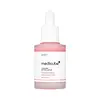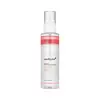What's inside
What's inside
 Key Ingredients
Key Ingredients

 Benefits
Benefits

 Concerns
Concerns

 Ingredients Side-by-side
Ingredients Side-by-side

Water
Skin ConditioningGlycerin
HumectantDipropylene Glycol
HumectantIsopropyl Myristate
EmollientGlycereth-26
HumectantNiacinamide
Smoothing1,2-Hexanediol
Skin ConditioningSodium Dna
Skin ConditioningButylene Glycol
HumectantPolyglycerin-3
HumectantSodium Acrylate/Sodium Acryloyldimethyl Taurate Copolymer
Emulsion StabilisingPolyisobutene
Acrylates/C10-30 Alkyl Acrylate Crosspolymer
Emulsion StabilisingMilt Extract
Skin ConditioningTromethamine
BufferingGlyceryl Acrylate/Acrylic Acid Copolymer
HumectantPvm/Ma Copolymer
Emulsion StabilisingEthylhexylglycerin
Skin ConditioningCaprylyl Glycol
EmollientParfum
MaskingMelia Azadirachta Leaf Extract
Skin ConditioningAdenosine
Skin ConditioningCaprylyl/Capryl Glucoside
CleansingSorbitan Oleate
EmulsifyingMelia Azadirachta Flower Extract
Skin ConditioningSodium Hyaluronate
HumectantDisodium EDTA
Curcuma Longa Root Extract
MaskingCyanocobalamin
Skin ConditioningHydrolyzed Collagen
EmollientUbiquinone
AntioxidantOcimum Sanctum Leaf Extract
Skin ConditioningCorallina Officinalis Extract
Skin ConditioningPalmitoyl Pentapeptide-4
Skin ConditioningPalmitoyl Tripeptide-1
Skin ConditioningPalmitoyl Tetrapeptide-7
Skin ConditioningCopper Tripeptide-1
Skin ConditioningAcetyl Hexapeptide-8
HumectantSalmon Egg Extract
Atelocollagen
Skin ConditioningWater, Glycerin, Dipropylene Glycol, Isopropyl Myristate, Glycereth-26, Niacinamide, 1,2-Hexanediol, Sodium Dna, Butylene Glycol, Polyglycerin-3, Sodium Acrylate/Sodium Acryloyldimethyl Taurate Copolymer, Polyisobutene, Acrylates/C10-30 Alkyl Acrylate Crosspolymer, Milt Extract, Tromethamine, Glyceryl Acrylate/Acrylic Acid Copolymer, Pvm/Ma Copolymer, Ethylhexylglycerin, Caprylyl Glycol, Parfum, Melia Azadirachta Leaf Extract, Adenosine, Caprylyl/Capryl Glucoside, Sorbitan Oleate, Melia Azadirachta Flower Extract, Sodium Hyaluronate, Disodium EDTA, Curcuma Longa Root Extract, Cyanocobalamin, Hydrolyzed Collagen, Ubiquinone, Ocimum Sanctum Leaf Extract, Corallina Officinalis Extract, Palmitoyl Pentapeptide-4, Palmitoyl Tripeptide-1, Palmitoyl Tetrapeptide-7, Copper Tripeptide-1, Acetyl Hexapeptide-8, Salmon Egg Extract, Atelocollagen
Water
Skin ConditioningCollagen Water
HumectantDipropylene Glycol
HumectantC13-15 Alkane
SolventRicinus Communis Seed Oil
MaskingGlycereth-26
Humectant1,2-Hexanediol
Skin ConditioningNiacinamide
SmoothingSodium Chloride
MaskingSorbitol
HumectantHydroxyethyl Urea
HumectantButylene Glycol
HumectantHelianthus Annuus Seed Oil
EmollientParfum
MaskingEthylhexylglycerin
Skin ConditioningEclipta Prostrata Extract
Skin ConditioningAdenosine
Skin ConditioningSodium Dna
Skin ConditioningMelia Azadirachta Leaf Extract
Skin ConditioningGlutathione
Paeonia Lactiflora Root Extract
Skin ConditioningMoringa Oleifera Seed Oil
EmollientCandida Bombicola/Glucose/Methyl Rapeseedate Ferment
AntimicrobialRosa Damascena Flower Water
MaskingBiotin
AntiseborrhoeicHexapeptide-2
BleachingBiotinoyl Tripeptide-1
Acetyl Hexapeptide-8
HumectantTripeptide-1
Skin ConditioningTripeptide-3
Skin ConditioningMyristoyl Pentapeptide-17
Skin ConditioningHexapeptide-9
Skin ConditioningWater, Collagen Water, Dipropylene Glycol, C13-15 Alkane, Ricinus Communis Seed Oil, Glycereth-26, 1,2-Hexanediol, Niacinamide, Sodium Chloride, Sorbitol, Hydroxyethyl Urea, Butylene Glycol, Helianthus Annuus Seed Oil, Parfum, Ethylhexylglycerin, Eclipta Prostrata Extract, Adenosine, Sodium Dna, Melia Azadirachta Leaf Extract, Glutathione, Paeonia Lactiflora Root Extract, Moringa Oleifera Seed Oil, Candida Bombicola/Glucose/Methyl Rapeseedate Ferment, Rosa Damascena Flower Water, Biotin, Hexapeptide-2, Biotinoyl Tripeptide-1, Acetyl Hexapeptide-8, Tripeptide-1, Tripeptide-3, Myristoyl Pentapeptide-17, Hexapeptide-9
 Reviews
Reviews

Ingredients Explained
These ingredients are found in both products.
Ingredients higher up in an ingredient list are typically present in a larger amount.
1,2-Hexanediol is a synthetic liquid and another multi-functional powerhouse.
It is a:
- Humectant, drawing moisture into the skin
- Emollient, helping to soften skin
- Solvent, dispersing and stabilizing formulas
- Preservative booster, enhancing the antimicrobial activity of other preservatives
Acetyl Hexapeptide-8, commonly known as Argireline or Acetyl Hexapeptide-3, is a popular peptide in skincare. It’s often referred to as a “Botox-like” ingredient because it helps reduce muscle movement.
By relaxing these micro-movements, Argireline may help minimize the appearance of fine lines and wrinkles. That said, it’s not as powerful as Botox, and research on its long-term effectiveness is still limited.
Beyond smoothing, Argireline may also support collagen production. Collagen is the protein that helps keep your skin firm, bouncy, and well-hydrated by strengthening the skin barrier.
So while Argireline isn’t a miracle fix, it can be a helpful addition to a routine focused on both prevention and skin health.
Read more about other common types of peptides here:
Learn more about Acetyl Hexapeptide-8Adenosine is in every living organism. It is one of four components in nucleic acids that helps store our DNA.
Adenosine has many benefits when used. These benefits include hydrating the skin, smoothing skin, and reducing wrinkles. Once applied, adenosine increases collagen production. It also helps with improving firmness and tissue repair.
Studies have found adenosine may also help with wound healing.
In skincare products, Adenosine is usually derived from yeast.
Learn more about AdenosineButylene Glycol (or BG) is used within cosmetic products for a few different reasons:
Overall, Butylene Glycol is a safe and well-rounded ingredient that works well with other ingredients.
Though this ingredient works well with most skin types, some people with sensitive skin may experience a reaction such as allergic rashes, closed comedones, or itchiness.
Learn more about Butylene GlycolDipropylene Glycol is a synthetically created humectant, stabilizer, and solvent.
This ingredient helps:
Dipropylene glycol is technically an alcohol, but it belongs to the glycol family (often considered part of the ‘good’ alcohols). This means it is hydrating and gentle on skin unlike drying solvent alcohols like denatured alcohol.
As a masking agent, Dipropylene Glycol can be used to cover the smell of other ingredients. However, it does not have a scent.
Studies show Dipropylene Glycol is considered safe to use in skincare.
Learn more about Dipropylene GlycolEthylhexylglycerin (we can't pronounce this either) is commonly used as a preservative and skin softener. It is derived from glyceryl.
You might see Ethylhexylglycerin often paired with other preservatives such as phenoxyethanol. Ethylhexylglycerin has been found to increase the effectiveness of these other preservatives.
Glycereth-26 is a synthetic ingredient and polyethylene glycol ether of Glycerin. Glycerin is already naturally found in your skin and helps keep your skin moisturized.
It is a humectant and helps add texture to products. It can make your product thicker.
As a humectant, it helps draw moisture from the air to your skin. This helps your skin stay hydrated.
Learn more about Glycereth-26Melia Azadirachta Leaf Extract is extract from the neem plant.
The leaves of this tree contain flavonoids and polyphenols. These two compounds are antioxidants, anti-inflammatory, and antibacterial. Further research is needed as to their effects when applied on skin.
Niacinamide is a multitasking form of vitamin B3 that strengthens the skin barrier, reduces pores and dark spots, regulates oil, and improves signs of aging.
And the best part? It's gentle and well-tolerated by most skin types, including sensitive and reactive skin.
You might have heard of "niacin flush", or the reddening of skin that causes itchiness. Niacinamide has not been found to cause this.
In very rare cases, some individuals may not be able to tolerate niacinamide at all or experience an allergic reaction to it.
If you are experiencing flaking, irritation, and dryness with this ingredient, be sure to double check all your products as this ingredient can be found in all categories of skincare.
When incorporating niacinamide into your routine, look out for concentration amounts. Typically, 5% niacinamide provides benefits such as fading dark spots. However, if you have sensitive skin, it is better to begin with a smaller concentration.
When you apply niacinamide to your skin, your body converts it into nicotinamide adenine dinucleotide (NAD). NAD is an essential coenzyme that is already found in your cells as "fuel" and powers countless biological processes.
In your skin, NAD helps repair cell damage, produce new healthy cells, support collagen production, strengthen the skin barrier, and fight environmental stressors (like UV and pollution).
Our natural NAD levels start to decline with age, leading to slower skin repair, visible aging, and a weaker skin barrier. By providing your skin niacinamide, you're recharging your skin's NAD levels. This leads to stronger, healthier, and younger looking skin.
Another name for vitamin B3 is nicotinamide. This vitamin is water-soluble and our bodies don't store it. We obtain Vitamin B3 from either food or skincare. Meat, fish, wheat, yeast, and leafy greens contain vitamin B3.
The type of niacinamide used in skincare is synthetically created.
Learn more about NiacinamideParfum is a catch-all term for an ingredient or more that is used to give a scent to products.
Also called "fragrance", this ingredient can be a blend of hundreds of chemicals or plant oils. This means every product with "fragrance" or "parfum" in the ingredients list is a different mixture.
For instance, Habanolide is a proprietary trade name for a specific aroma chemical. When used as a fragrance ingredient in cosmetics, most aroma chemicals fall under the broad labeling category of “FRAGRANCE” or “PARFUM” according to EU and US regulations.
The term 'parfum' or 'fragrance' is not regulated in many countries. In many cases, it is up to the brand to define this term.
For instance, many brands choose to label themselves as "fragrance-free" because they are not using synthetic fragrances. However, their products may still contain ingredients such as essential oils that are considered a fragrance by INCI standards.
One example is Calendula flower extract. Calendula is an essential oil that still imparts a scent or 'fragrance'.
Depending on the blend, the ingredients in the mixture can cause allergies and sensitivities on the skin. Some ingredients that are known EU allergens include linalool and citronellol.
Parfum can also be used to mask or cover an unpleasant scent.
The bottom line is: not all fragrances/parfum/ingredients are created equally. If you are worried about fragrances, we recommend taking a closer look at an ingredient. And of course, we always recommend speaking with a professional.
Learn more about ParfumSodium DNA is an emerging anti-aging ingredient.
It is created by taking deoxyribonucleic acid (DNA) and purifying it with sodium hydroxide.
The DNA is extracted from several different animal sources, including: calf thymus, the gonadic tissue of a male sturgeon, or herring / salmon sperm.
You have probably seen this ingredient in anti-aging skincare. But what is it?
DNA is composed of nucleotides, or chemical building blocks. Nucleotides include adenine (A), thymine (T), guanine (G), and cytosine (C). Talk about a flashback to biology! Nucleosides are formed from these nucleotides.
The science behind Sodium DNA is based on an ingredient called Polydeoxyribonucleotide or PDRN.
PDRN are DNA fragments mainly extracted from the sperm cells of trout or salmon. Meaning, PDRN can be derived from Sodium DNA.
PDRN consists of chains of nucleotides and nucleosides mentioned above. They can range anywhere from 80 - 2000 pairs.
Studies show PDRN has the following properties:
Most of the research on PDRN has been done using injectable forms. That’s important, because PDRN is a large molecule and doesn’t absorb well through the skin. So if you’re applying it topically, the effects are likely to be much milder.
Still, topical Sodium DNA is emerging as a trendy anti-aging ingredient. It’s generally well-tolerated and offers good biocompatibility with human skin, making it a low-risk addition to most routines.
Further studies are needed to truly confirm this ingredients anti-aging ability (Remember, retinol has decades of research!).
When using this ingredient, is is best to ask a brand about the source of their Sodium DNA. You'll want to find products where the Sodium DNA is sourced from fish. Some Sodium DNA is derived from calf / cow thymus.
Needless to say, this ingredient is not vegan.
Learn more about Sodium DnaWater. It's the most common cosmetic ingredient of all. You'll usually see it at the top of ingredient lists, meaning that it makes up the largest part of the product.
So why is it so popular? Water most often acts as a solvent - this means that it helps dissolve other ingredients into the formulation.
You'll also recognize water as that liquid we all need to stay alive. If you see this, drink a glass of water. Stay hydrated!
Learn more about Water